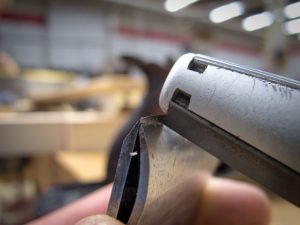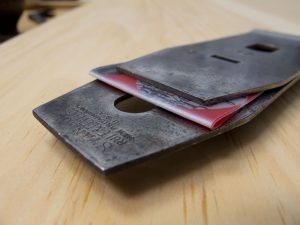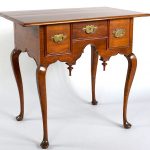We may receive a commission when you use our affiliate links. However, this does not impact our recommendations.
Chipbreakers were invented in 1846 by the devil.
Yes, they can eliminate tear-out when set .007” from the cutting edge of your smoothing plane. But otherwise, chipbreakers seem to cause more ulcers than they fix.
I see a lot of mucked-up chipbreakers on students’ planes. And when you are in a two-day class, you cannot say: Go order a new breaker and iron and then you’ll be fine. You have to fix the puppy right then and there.
Here are two last-ditch tricks.
Trick 1: When the breaker won’t mate. The most common chipbreaker malady is that its front edge will not fit tightly on the back of the iron. And the gaps are shaving traps – two strokes and your mouth is fouled.
The cause of the problem can be that the front edge of the breaker is mucked up. Or, even worse, the back of the iron has a big old hump on it from ham-handed sharpening.
The first thing I tell students to do is to stone the leading edge of the chipbreaker. Or, in certain cases, to file it in the middle to create complementary surfaces between the breaker and iron.
Sometimes, that isn’t enough. And so I fetch my burnisher. I screw the breaker and iron together and then run the corner of my burnisher on the leading edge of the chipbreaker. This deforms the metal on the tip of the breaker and almost always fills in any gaps.
It’s a temporary solution – the deformed metal can flake off when you remove the breaker to sharpen the iron. But it works like crazy in the field.
Note: You can also use any other super-hard pointy thing to deform the breaker, including a nail set or an awl.
Trick 2: When the iron is bent. In this new age of aftermarket irons and breakers, I have seen a new problem surface with chipbreakers. The breakers are so stout that they can bend the iron into a curve. This causes all sorts of problems. The iron doesn’t mate on the frog or bed of the plane. And, after some time, the breaker won’t mate on the back of the iron, either.
What to do? Shim the back of the breaker. I use pieces of plastic or whatever is handy to shim the breaker behind its screw. This pushes the front edge down against the iron.
You can also use this trick when the breaker is too flat after years of use and being under tension. The shim will add new spring.
As I said above, these are temporary “get it done” fixes. You might think they are a bit redneck-y and sloppy, and to that I say: Soooooooooooie pig.
— Christopher Schwarz
Find more tricks and tips for handplanes in “Handplane Essentials,” available now in paperback for less money at ShopWoodworking.com.
Here are some supplies and tools we find essential in our everyday work around the shop. We may receive a commission from sales referred by our links; however, we have carefully selected these products for their usefulness and quality.











Chris,
I think I can’t have encountered blades and chipbreakers as badly abused as the ones you describe!
The burnisher on the c/b edge is neat, I have seen something similar in an old book.
David
Chris,
As far as I am aware chipbreakers have always bent blades, and this is not such a bad thing,
Blades do not sit flat on frogs and lever caps do not flatten the assembly of blade and chipbreaker.
David
What’s a chipbreaker?, says he who uses bevel up planes 🙂
I like practical even when it is rednecky. As for cell phones, mine earns money 7/24 even if it doesn’t ring; I like that. What is a Hudy?
Country in NC
As an owner of a custom Hock chip breaker to replace the one on a stanly transitional (metal screw adjustments on a wood body), with a stock iron, I can verify that the iron does indeed bend after a while. I had been thinking that shimming would just be tom-foolery, but now I think I’ll at least give it a try, probably with some wood shims as suggested above – may with some sanded/filed sheet metal.
Russ
Chris I have a hard time seeing you as redneck-y, even given your state of residence. Redneck-y is the guy sitting at the bar with a can of Hudepohl, thinking about his best hunting dog, and liking life, a lot. Probably with a dirty baseball cap, and without a sports team logo, something farm, or NASCAR related. A guy that prefers $6.00 beers hardly matches that description.
The shim is possibly the better of the two fixes. You already have wood, make a thin cutoff, and get busy. Plus sawing off tight cuts is good practice.
What kind of burnisher is that?
Perhaps I am not seeing this correctly, but wouldn’t the shim exacerbate the curvature? I’m imagining a blade being drawn into the breaker and the tip being pushed down. Is that what we’re after? Damn, now I’m confused…
The Devil seems to have his hand in lots of things. He invented the telephone thereby abrogated the convenience of being at home in peace and not being interrupted incessantly by so called friends and relatives. Then, in an apparent encore performance, he joined Motorola and invented the cell phone.
Ok, you all stay safe and keep alert!
Albert A Rasch